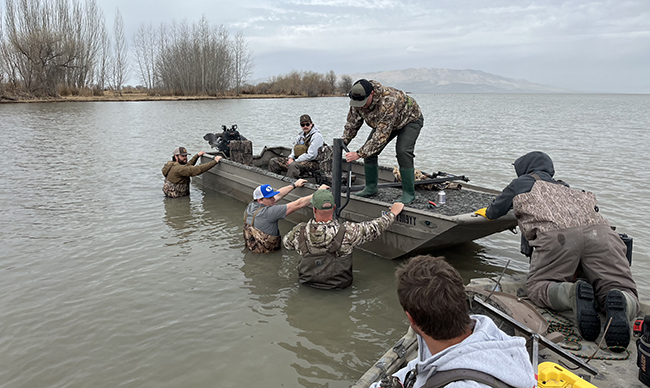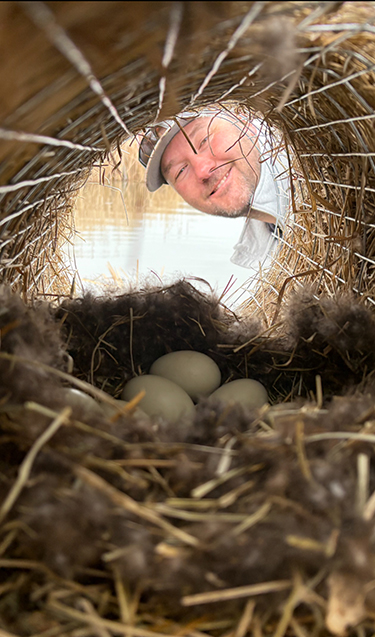Chapter-Installed Hen Houses Showing Impressive Rates of Usage in Utah

Targeting areas with established mallard nesting is essential for Hen House success
Over the past three years, new structures in the wetlands of Utah Lake’s Provo Bay have been quietly helping local mallards beat the odds.
The Provo Bay Chapter of Delta Waterfowl, founded in 2022, recently held its third annual fundraising banquet in support of waterfowl conservation. Like all Delta chapters, Provo Bay retains at least 15% of the funds it raises via Delta’s Waterfowl Heritage Fund to support local projects for ducks and duck hunters. The remaining dollars go toward Delta’s large-scale Duck Production, Habitat Conservation, Research and Education, and HunteR3 work across North America.

This chapter directed its WHF investment in Hen Houses on Utah Lake, situated less than 50 miles southeast of the historically important waterfowl breeding grounds of the Great Salt Lake.
“We all (the committee) had a great passion for Utah Lake and specifically Provo Bay, so we wanted to give back to that area,” said chapter chairman Dallis Davis. “We loved the idea of Hen Houses, so we started working with the Utah Division of Wildlife Resources and the Utah Lake Authority—the governing agency that manages the sovereign land at the Utah Lake property. We wanted to get their buy-in for the Hen House structures on the lake, and we also needed permitting to go out there and install them.”
Delta Waterfowl’s Hen Houses are elevated nesting structures used almost exclusively by mallards. Hen Houses don’t bring ducks to an area if they weren’t already planning on breeding somewhere nearby—rather, they protect hens and their eggs from mammalian and avian predators in areas where mallards are already likely to nest.
In the PPR, where the majority of Delta’s Hen Houses are deployed, these structures are installed in locations with the highest densities of breeding ducks and limited nesting cover. There, they consistently boost nest success to more than 60%, and in some cases up to 80 percent—compared to lower than 10% for typical ground nests.
Understanding how and where Hen Houses work best, the Provo Bay Chapter put their plan into action. In the spring of 2023, chapter volunteers installed 12 Hen Houses. While it’s normal for these structures to take several years before they’re fully adopted by nesting hens, they saw seven of the 12 used in the first season alone. Encouraged by the uptake, they added 18 more the following year.
“In the spring of 2024, 23 of the 30 Hen Houses were used, and 11 of those 23 were used a second time,” said Davis. “Between the nests that were used multiple times, we ended up having utilization rate over a 100%. That was really exciting!”
Their growing success caught the attention of local media, with several outlets joining the chapter in the field during this year’s installation efforts.
 “On the 29 of March we installed 25 new Hen Houses, relocated four, and then cleaned and freshened up the remaining structures out there,” Davis said. “We already had one hen nesting that had laid 14 eggs and was sitting on her clutch, which is just absolutely incredible.”
“On the 29 of March we installed 25 new Hen Houses, relocated four, and then cleaned and freshened up the remaining structures out there,” Davis said. “We already had one hen nesting that had laid 14 eggs and was sitting on her clutch, which is just absolutely incredible.”
The Provo Bay Chapter is made up of 16 committee members and a steady group of volunteers, all eager to check on the new nests this season.
“While every nesting project is special, this one is unique due to being here in the desert, in a state that used to raise a great deal of ducks but has declined over the years,” said Jeff Adams, Delta’s regional director for the area. “It is also unique due to our fabulous mountain backdrop where these beautiful ducks choose to nest!”
While Hen Houses are a proven tool in Delta’s Duck Production toolbox, they’re most effective when installed where ducks already choose to nest.
“Delta’s programs install Hen Houses throughout the prairie pothole region of North America, where dense breeding duck populations, limited nesting cover, and high rates of predation drastically impact waterfowl breeding success,” said Joel Brice, chief conservation officer for Delta Waterfowl. “What’s happening in Provo Bay is truly exceptional. Seeing such strong adoption rates outside our core delivery area highlights the power of local chapters and their role in supporting duck production across the continent. It’s incredibly rewarding to see this kind of success—it shows what’s possible when passionate volunteers put the right tools in the right places.”
Looking ahead, the Provo Bay Chapter plans to continue expanding its Hen House project. With continued collaboration from the Utah Lake Authority and the Utah DWR, their long-term vision includes up to 100 Hen Houses across Provo Bay to support nesting mallards for years to come.
“We look forward to following along with their successes,” said Adams. “They’re an incredibly motivated group of waterfowl hunters who care deeply about ducks. It’s great to see them sharing that with their local community and having a real impact on local populations.”
For more information on Delta’s Hen House program, contact Matt Chouinard, waterfowl programs director, at mchouinard@deltawaterfowl.org. —Christy Sweigart
Photo Credit: Dallis Davis
The post Chapter-Installed Hen Houses Showing Impressive Rates of Usage in Utah appeared first on Delta Waterfowl.
This article originally appeared on this site.


Leave a Reply